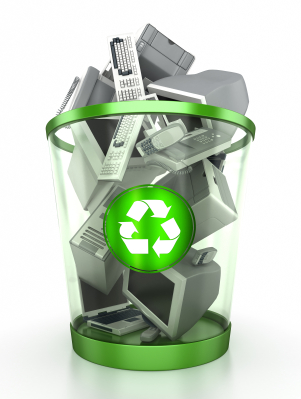According to the EPA, electronic waste contributes 70% of the toxins found in landfills. Electronic waste, or e-waste, contains some very toxic materials, including mercury, lead, cadmium, arsenic, beryllium and brominated flame-retardants. According to e-Stewards, when the latter are “burned at low temperatures they create additional toxins, such as halogenated dioxins and furans — some of the most toxic substances known to humankind. The toxic materials in electronics can cause cancer, reproductive disorders, endocrine disruption, and many other health problems if this waste stream is not properly managed.”
 Regrettably, a very small percentage of e-waste is recycled.
As little as 11% to 14% of e-waste in the U.S. is estimated to be recycled. The remainder is dumped into landfills or burned in incinerators. These unacceptable methods of disposal fail to recover precious materials or manage toxic materials safely. In addition, approximately 70% to 80% of the e-waste given to recyclers is exported to countries where primitive extraction methods are sometimes used and the toxins contaminate local soil, air and groundwater.
Examples of toxins within your e-waste:
Regrettably, a very small percentage of e-waste is recycled.
As little as 11% to 14% of e-waste in the U.S. is estimated to be recycled. The remainder is dumped into landfills or burned in incinerators. These unacceptable methods of disposal fail to recover precious materials or manage toxic materials safely. In addition, approximately 70% to 80% of the e-waste given to recyclers is exported to countries where primitive extraction methods are sometimes used and the toxins contaminate local soil, air and groundwater.
Examples of toxins within your e-waste:
 Regrettably, a very small percentage of e-waste is recycled.
As little as 11% to 14% of e-waste in the U.S. is estimated to be recycled. The remainder is dumped into landfills or burned in incinerators. These unacceptable methods of disposal fail to recover precious materials or manage toxic materials safely. In addition, approximately 70% to 80% of the e-waste given to recyclers is exported to countries where primitive extraction methods are sometimes used and the toxins contaminate local soil, air and groundwater.
Examples of toxins within your e-waste:
Regrettably, a very small percentage of e-waste is recycled.
As little as 11% to 14% of e-waste in the U.S. is estimated to be recycled. The remainder is dumped into landfills or burned in incinerators. These unacceptable methods of disposal fail to recover precious materials or manage toxic materials safely. In addition, approximately 70% to 80% of the e-waste given to recyclers is exported to countries where primitive extraction methods are sometimes used and the toxins contaminate local soil, air and groundwater.
Examples of toxins within your e-waste:
- Cathode ray tube monitors and older TVs contain lead, which can taint incinerator ash (see “Other disturbing information” below).
- Circuit boards contain lead (in the solder), mercury (in switches and relays) and brominated flame-retardants.
- Flat-panel video displays typically contain one or more mercury-containing lamps.
- Smartphones and laptops contain heavy metals like cadmium, beryllium and hexavalent chromium, or arsenic, which have been shown to build up in both our bodies and the environment.
- The wires and cables that run through electronics are often coated with polyvinyl chloride, which contains toxic additives called phthalates.
- E-waste in Gulyu, China is often simply burned, resulting in severe pollution of ground, water and air.
- Ash piles in Gulyu have been found to have lead concentrations 200 times U.S. regulatory limits.
- 82% of small children tested in Gulyu were found to have clinical lead poisoning.